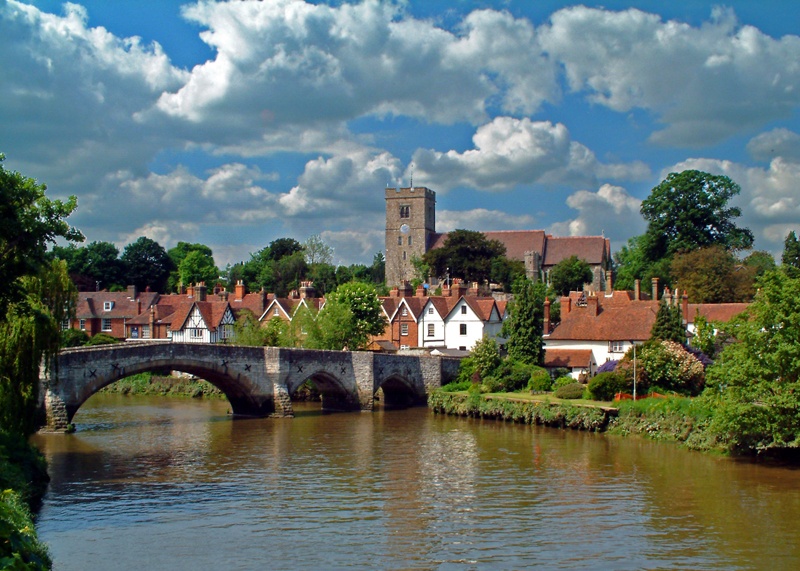
Aylesford Village - Image by PicturesOfEngland.com member Andrew Whittaker (view gallery)
This list contains some of the best picturesque villages to visit that are within an hour or two of London, and no further. There are over ten to choose from here, with links to more pictures of each village and more information.
If you would like to add your pictures, please do, and if you can recommend any of these villages, or indeed any other picturesque village worth a visit near London, then please let us all know in the comments section below, as we want this list to be as helpful as possible for those visiting London who want to take a trip out to experience one of our quintessential English villages. Thank you.
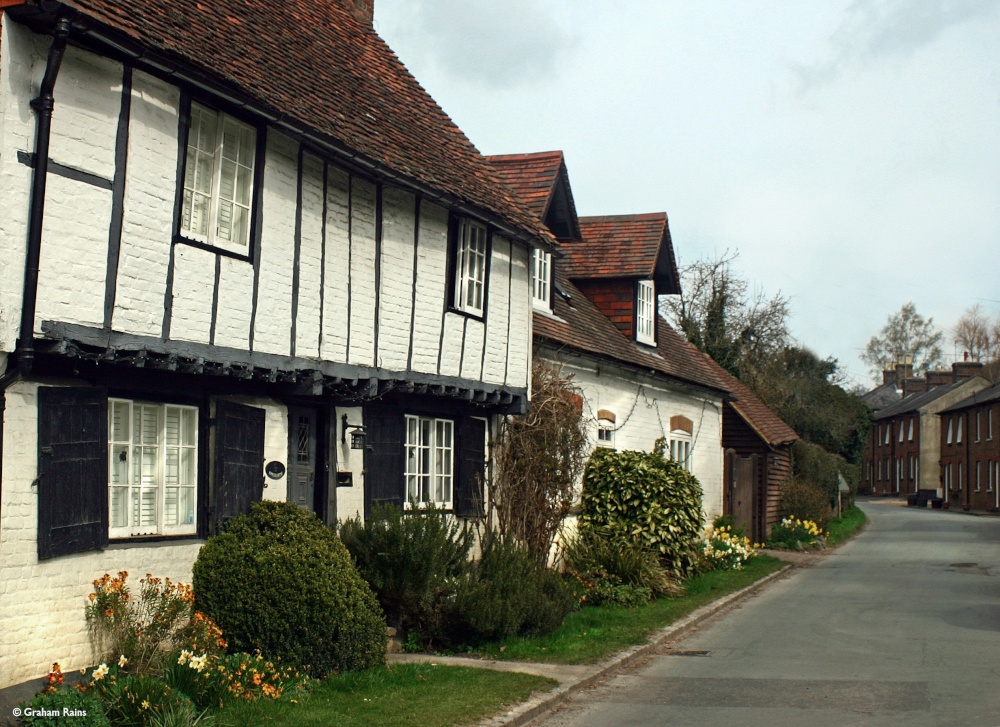
Aldbury, Hertfordshire. - Image by PicturesOfEngland.com member Graham Rains (view gallery)
Lying on the edge of the Chiltern Hills this is one of the counties most attractive villages. It is quintessentially English with delightful cottages and houses, a duck pond, whipping post and ancient stocks.
Overlooking the pond is the village church, this is Early English in style with a square embattled tower. The oldest parts of the church date to the 13th century, there is a long, low nave and low chancel. The church shows delightful lancet windows and contains several ancient tombs.
Of the properties to be seen in the centre of the village there are two ancient inns, The Greyhound is an historic former coaching inn, and the Valiant Trooper is carved from an assembly of picturesque 18th century cottages.
With village streets that are a delight to wander, leafy lanes down which you may chance to meet jockey's exercising horses from the nearby Walter Swinburn Stables, this is truly a village in which to relax and unwind. It has a pace of life far removed from the hurry of everyday life and is a place that makes you feel you can stroll along with a song in your heart.
From the brow of a hill clustered with beeches, a massive granite 200 foot high column looks down over the village. The column was erected in honour of the third Duke of Bridgewater, in commemoration of his pioneering of the English canals. From this superb vantage point the views of Aldbury and surrounding scenery are nothing less than spectacular.
ID#24414

Part of the High street, Aylesford, Kent - Image by PicturesOfEngland.com member Paul D (view gallery)
Aylesford is a large village in Kent, 4 miles NW of the county town of Maidstone. It sits on the river Medway, and has many interesting and historic buildings including the 14th century Medieval bridge, and Aylesford Priory (The Friars) - founded in 1242 when the first Carmelites arrived from Mount Carmel in the Holy Land.
Aylesford's picturesque bridge is a well preserved medieval multi-span bridge across the river Medway believed to date from the 14th century.
The Priory, or Friars, in Aylesford, Kent, contains one of the finest intact medieval courtyards in England, 17th-century thatched barns and a hostelry for pilgrims dating to the late 1200s. It is also described as having one of the best collections of religious modern art in England with its sculptures, paintings, stained glass and ceramics.
Their are several chamber tombs at Aylesford, just north of the village, the most famous being Kity Coty House, a chambered long barrow constructed around 4000BCE.
Aylesford Newsprint was a long-established major employer in the area and was the largest paper recycling factory in Europe.
The name Aylesford derives from ‘Ægel’s ford’ - Aegel being a chieftain who controlled the crossing of the river.
ID#15
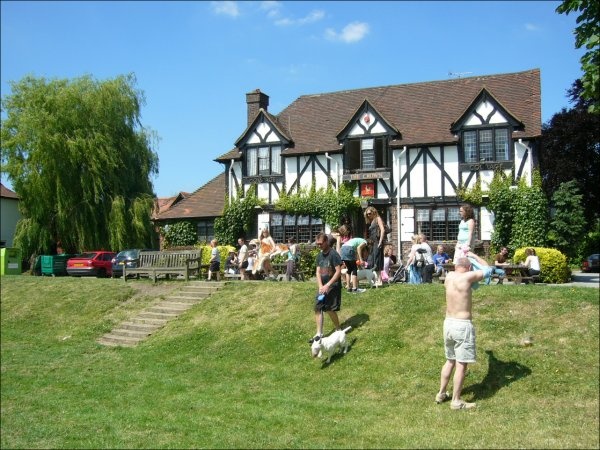
The Crown Pub on the Moor. Cookham, Berkshire - Image by PicturesOfEngland.com member Liz Kwantes (view gallery)
This beautiful old village lies in the thickly wooded Cliveden Reach of the Thames, a fine stretch of water that begins at Cookham Lock. The area is widely known for the quaint ceremony of Swan Upping. This is when the Royal Swankeeper catches the new cygnets, and claims ownership on behalf of H.M. Queen Elizabeth II, this is a colourful ceremony, it attracts visitors from all over and, taking place in late July means that children can attend.
Cookham is a popular haunt of Artists, it has links with Sir Stanley Spencer and was his home until his death in 1959. Look closely at any number of his paintings and you can see how well he used the fine countryside around Cookham as a backdrop for his many subjects. One of Sir Stanley's finest paintings is of the Swan Upping ceremony.
This is an area that is awash with attractive old properties, some of which date from the 14th-century. One of the oldest buildings is the church of The Holy Trinity, built in the 12th-century. In spite of restoration work from different periods the church remains largely Norman with a fine Perpendicular tower. The interior of the church is serene and beautiful, it contains many reminders of an ancient past and shows several interesting brasses and monuments.
Here in Cookham old and new blend harmoniously together, Cookham has modern shopping facilities and some handsome new developments. Fortunately though, it has lost none of its charm and continues as a favoured Thames riverside resort attracting visitors at every season of the year.
ID#26583
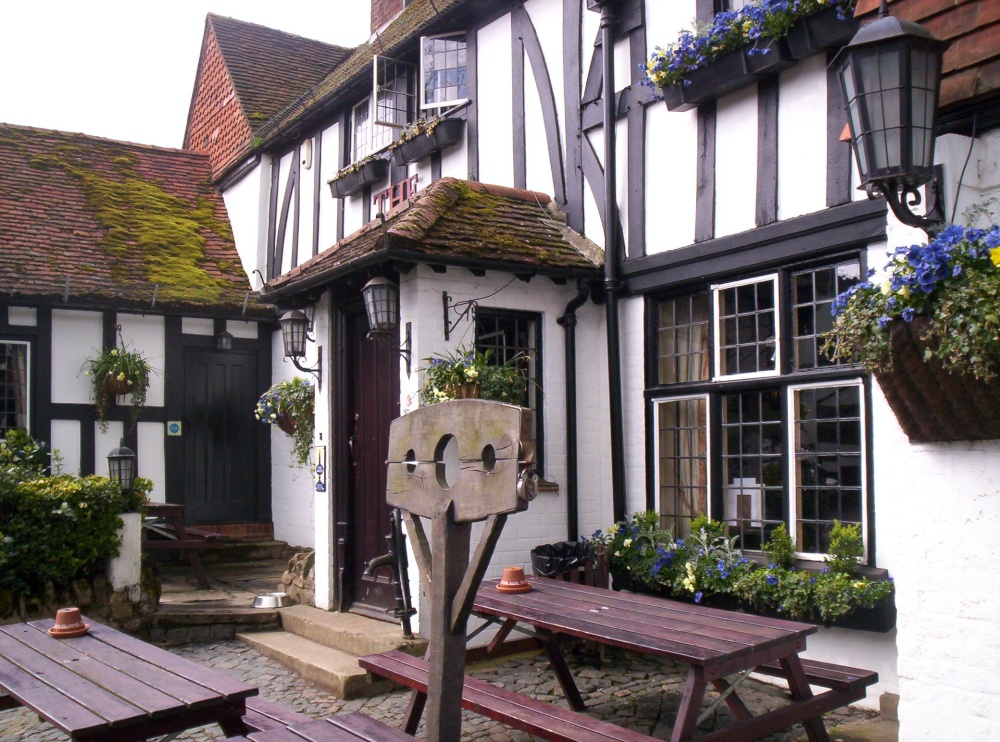
Village Stocks at the White Horse Pub, Shere, Surrey - Image by PicturesOfEngland.com member Brian Detweiler (view gallery)
This lovely tranquil village on the picturesque Tillingbourne, nestles beneath the rolling countryside of the North Downs. It is rich with pretty cottages with black and white timber-framing, many with over-hanging first storeys, with some dating from the 16th century.
The attractive Church of St.James is approached via a Lych-gate designed by Sir Edwin Luytens in 1902. The church is believed to date from 1190, it has a Norman tower, and pointed arches characteristic of Early English style.
A legend exists telling of a time when King John visited the tree encircled waters of the Silent Pool lying a mile west of the village. He is said to have surprised a maiden bathing naked, she was so over-come that she slipped and drowned! Fact or fiction, this is still a delightful tale, the stuff that English country villages are made of.
Shere is found between Guildford and Dorking, lying close to the North Downs Way.
ID#29088
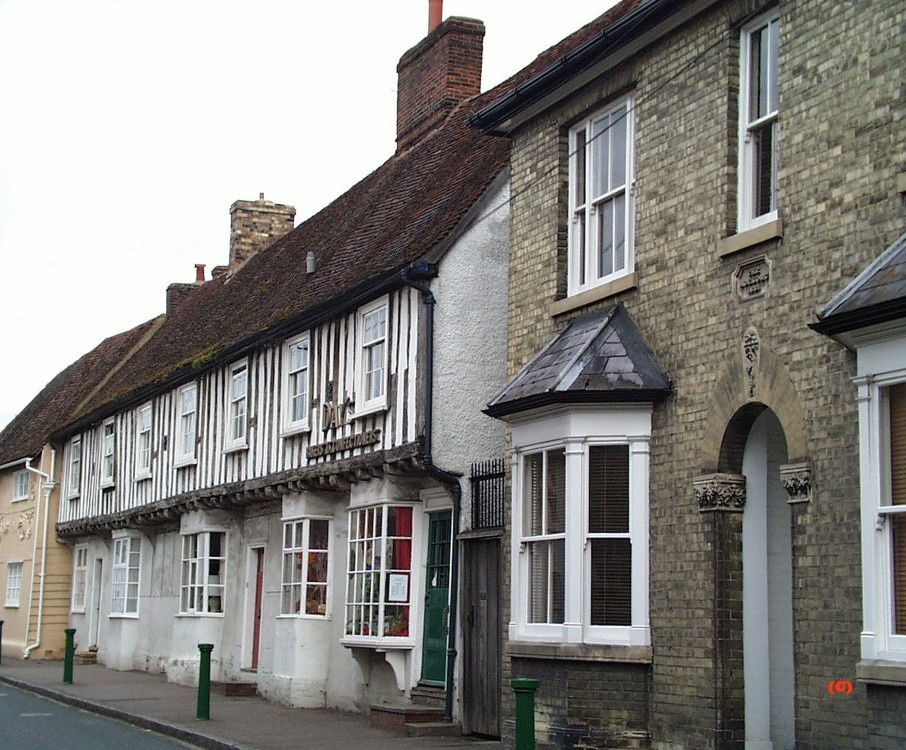
Main Street - Image by PicturesOfEngland.com member Paul Taylor (view gallery)
Ashwell embodies some of the finest domestic architecture in England, here in this well preserved village, at a glance you get a pleasurable insight as to what England was like in the 16th and 17th-centuries.
The Doomsday Book records Ashwell as a market town; the streets follow a well laid out plan and you can easily identify the old market place. The village is dominated by the spire of the beautiful 14th-century church dedicated to St. Mary around which there are many timber-framed and gable-brickwork houses. The most noted being St.John's Guildhall of 1861, the well restored Foresters Cottages, the Chantry House with its lovely 15th-century window and the picturesque 16th-century Town House which houses the village museum. Ashwell Bury, is a rather grand Victorian house which was remodelled by Luytens in the 1920's.
Delightfully situated on the chalk scarp of the springs line, in spacious open countryside between Royston and Baldock this attractive village with its little collection of pleasant village stores and three pubs makes a lovely location for a weekend exploration of some of Hertfordshire's quaint villages and beauty spots.
ID#22291
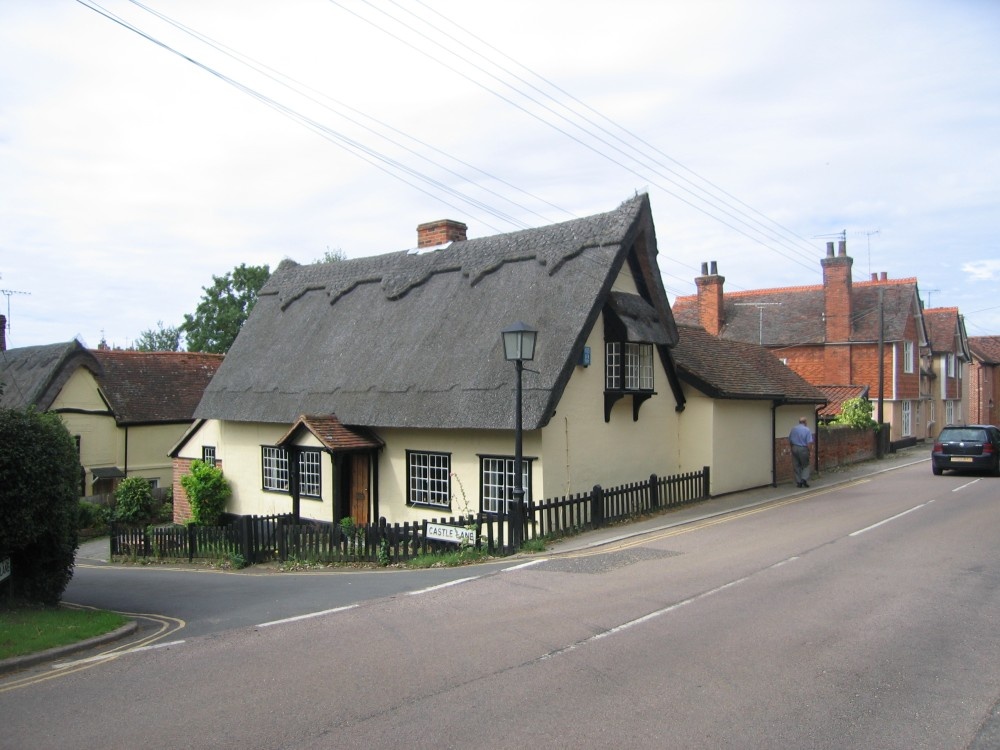
Castle Hedingham, Essex - Image by PicturesOfEngland.com member poe (view gallery)
Set in enchanting border countryside where the fine old counties of Suffolk and Essex meet, lies the delightful village of Castle Hedingham which has pleasant buildings and an historic castle to explore.
Hedingham Castle was built in the 12th-century by the DeVere family, who lived at the castle for many centuries, it is still owned by one of the DeVere descendents. The castle is remarkable for its towering Norman keep which is one of the best preserved in the country. It is also renowned for the 28ft Norman arch spanning the Banqueting Hall which is perhaps the only one of it's kind in England. Set within stunning grounds the castle stands four storeys high, has square turrets and walls 12ft thick. It is the perfect setting for many special events, these include medieval jousting tournaments and popular Have-a-Go archery. With so much to do, take part of and explore, the castle makes a lovely place for a family day out.
The village of Castle Hedingham, lies tucked beneath the castle. It is a tranquil place where you can see attractive medieval cottages and handsome Georgian houses. The Church of St.Nicholas is worth a visit, it is of Norman origin with a nave covered by a double hammerbeam roof. The tower bears the date 1616 and treasures of the interior include a 14th-century rood screen, beautifully carved misericords and a magnificent alter. The tree shaded churchyard reflects the peace of the church. At the Falcon Street entrance there is a tall stone cross which is a war memorial, there are a number of ancient gravestones and tombs belonging to noted local families. As one would suspect the church also holds memorials to the powerful DeVere family. The church has always played an important role in village life and today, like the village, it has a strong community spirit.
ID#22591
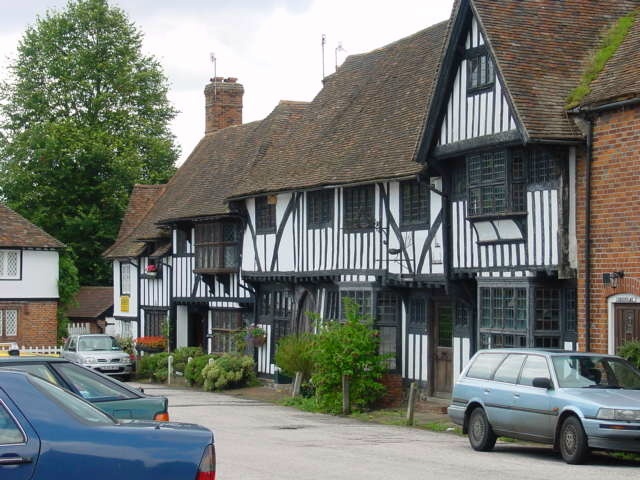
Chilham Street - Image by PicturesOfEngland.com member David Newton (view gallery)
Here you will find an attractive collection of Tudor black and white half-timbered houses assembled around a central village square. The impressive gates to Chilham Castle stand in the square, and peeping between the houses at the northern end of the square, is the clock-face tower of the Church of St. Mary. It is the most atmospheric square, and it is therefore unsurprising to learn it was featured in the film 'The Amorous Adventures of Moll Flanders' in around 1965.
Another historic aspect of the village is that it is said to be the last resting place of one of Julius Caesar's men. Julliberrie, was a captain in Caesar's army, he is said to be buried in a long barrow to the south of the village in the Valley of the Stour. The barrow is 150 foot long, is also supposed to be the spot where the Ancient Britons drove back the Roman army.
The romantic Jacobean mansion known as Chilham Castle was built for Sir Dudley Diggs, Master of the Rolls for James I, in 1616. It was designed by Inigo Jones, and the gardens were laid out by Capability Brown in 1777. In the grounds of the mansion you can see the original Norman Keep and Curtain walls of the earlier 12th-century castle.
Leaving behind the historic nature of Chilham, in recent times, certainly until well into the mid-nineties, it was the home of the British Jousting Association of Great Britain. It was a superb venue for lively events featuring knights in armour, in pitched battle for my ladies favour. Now all this is gone, the castle has been sold into private ownership to become an equestrian centre with a cross country course.
The parish Church of St.Mary dates from the 15th-century and is built of flint. It has an outstanding nave and chancel, decorative windows and a magnificent font supported by five columns. There is a white marble monument by the sculptor Sir Francis Chantry (1781-1841), who left his fortune to found a famous art collection. In the quiet churchyard you can see a lofty War Memorial and tombs and graves from past centuries.
Chilham is a place of extraordinary serenity, it is both picturesque and pleasant, a lovely place to spend a perfectly peaceful day or a quiet, romantic weekend.
ID#28752
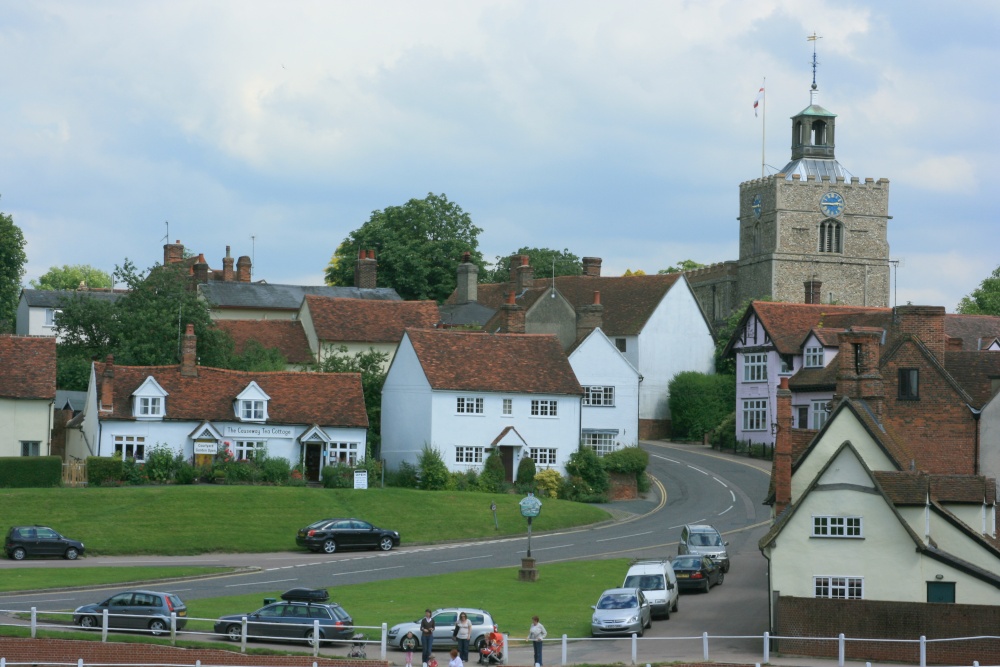
Finchingfield Parish Church - Image by PicturesOfEngland.com member Gwen Edwards © (view gallery)
This award winning village can be found 54 miles from London and has often been described as the 'most photographed village in England', winning many awards for its picturesque setting, with its traditional village duck pond, village green, pub and pretty cottages. A windmill, hump-backed bridge, and beautiful medieval church complete the picture of this quintessential English village close to Constable country in beautiful rural Essex.
There are many interesting buildings in the village including the Guildhall dating to around 1500, the Round House, or Pepper Pot house of 18th century Dutch design, and the Elizabethan Country House 'Spains Hall' which was built in the 15th century and is named after Hervey de Ispania, who was lord of the manor during the time of the Doomsday Book of 1086. Most of the villagers were once employed by the hall, which owned much of the village.
The village has been the subject of many paintings by various artists, including paintings by Lucien Pissaro (1863 - 1944) who visited the village and made several oil paintings.
The famous author Dodie Smith whose books included 'The Hundred and One Dalmations' is buried in the village, and a house once owned by her can be found along the same road as the village, about 1.5 miles outide it. It is a thatched property with a blue plaque memorial plate on the wall near the door.
ID#22800
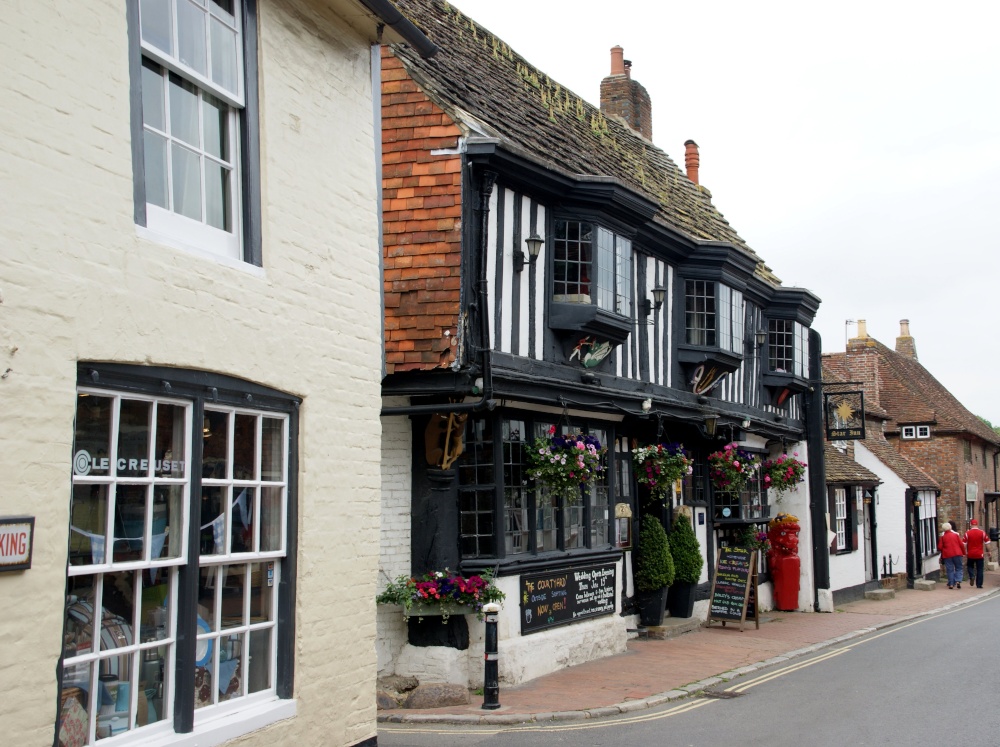
House view - Image by PicturesOfEngland.com member Hans Littel (view gallery)
Delightful east Sussex village mentioned in the Doomsday Book of 1086. It occupies a favoured position in the beautiful Cuckmere Gap and serves as a tourist village to which hoards of visitors flock to enjoy the many well preserved fine old buildings to be seen, one of the most important being the local church.
St.Andrew's Church is a 14th century cruciform church showing fragments of early glass, but the Jesse window in the south transept is from early in the 20th century. Inside the church are interesting historic relics, these include a piscina, triple sedilia, an Easter sepulchre. In these parts, this large church has become known as the Cathedral of the Downs.
The church rectory is a pre-reformation house constructed during the 14th century. It shows much timber-framing, and inside the living room is heavily beamed and has moulded king-posts. This lovely property is cared for by the National Trust who acquired it in 1896, it is known as Clergy House.
The noted Star Inn was reputedly built by the Abbot of Battle to be used as a hostel. It was later turned into an inn (c.1500) this remains today very much as it was then, with numerous faces and small carved figures peering over the passers-by. This is believed to be one of the countries oldest inns, it has a beautifully preserved interior with beams and open fires.
In the village the streets are crammed with old buildings tiled in Horsham tile, it is well worth a wander around to take a closer look at the remarkable character of these attractive properties, and others dating from as far back as the 15th century.
The village has had its share of strife, at the time of the Napoleonic wars it served as a dormitory village for troops who where settled there for fear of invasion should the French ever get past the Martello towers placed along the Sussex coast. During this period the village enjoyed a revival in fortunes, but when the troops left revenue dropped. It was then that the renowned Alfriston smugglers banded together and for a time the villagers lived on the proceeds of illicit contraband. The leader of the gang was caught in the 1830's, he was sent to Australia.
Alfriston, shouldered at each side by the south downs and amid the beauty of the Cuckmere Valley, makes an idyllic place to visit for a quiet weekend or as a base from which to explore all this lovely valley and coastal region has to offer.
For further information, please visit www.alfriston-village.co.uk
ID#32294
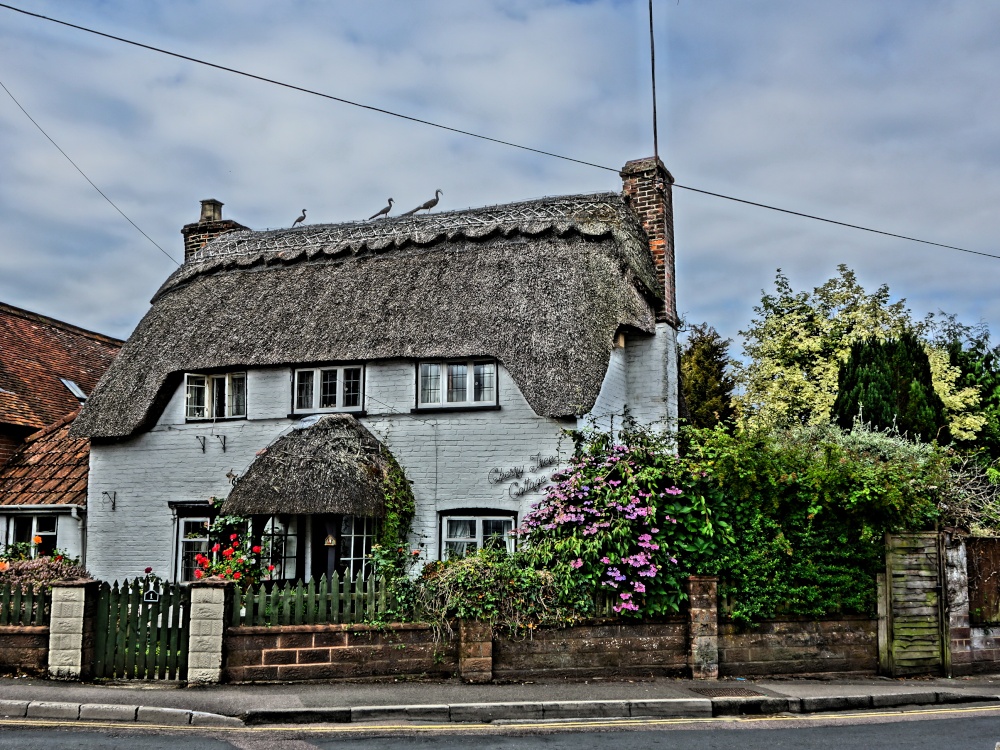
Cherry Tree cottage - Image by PicturesOfEngland.com member Victor Naumenko (view gallery)
Gloriously set, like a jewel in a crown, between woodland and heathland, is the picturesque place called Brockenhurst. It is within the New Forest but often referred to as a gateway to the New Forest, Brockenhurst is an ideal base from which to explore the bounties nature has heaped on this wonderful region. It is alive with flora and fauna and New Forest ponies can frequently be seen at the edge of the town. There are several hotels in the area, and one has an excellent Cricket pitch that is a good venue on a summer afternoon.
Brockenhurst is an ancient area which is echoed by the beautiful church which dates from Norman times. The interior of the church is cool and quite fascinating, it houses many treasures. A tower was added to the church at a later date which is thought to have been around 1781.
This is an area in which it is well worth spending time, there are wonderful walks in the forest and lovely old shops to be explored in the little villages and hamlets which inhabit this refreshing and magical region.
ID#443
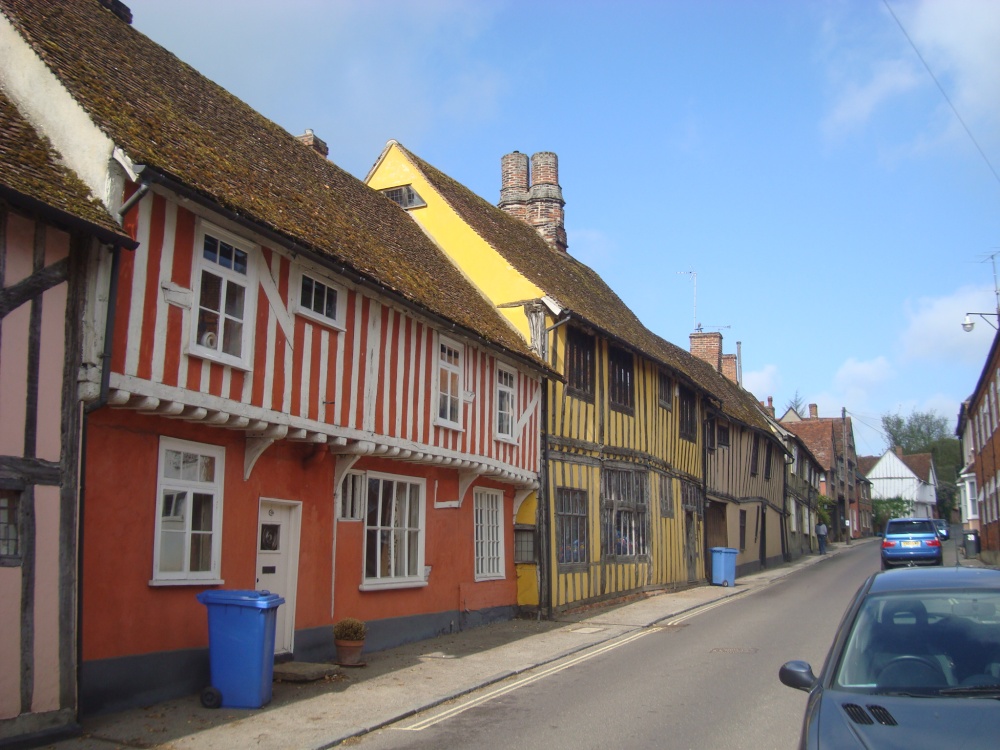
Water Street houses - Image by PicturesOfEngland.com member Victor Naumenko (view gallery)
Considered to be Britain's best preserved medieval village, Lavenham, with its wonderful clusters of fine Tudor houses offering the visitor a glimpse of just how a prosperous wool settlement must have looked during its' hey-day in the middle ages. The wealthy merchants of Lavenham and the wool trade have long since gone but still exists these grand old houses, churches and other beautiful buildings that have stood the test of time and bear witness to the towns enduring prosperity.
Justly proud of thier heritage are the local residents that Lavenham's telegraph poles were removed from view in 1967 and the lines hidden underground. Thus, the Market Place which dates back to the 13th century, looks today, very much as it did in medieval times.
The Guildhall which is known for being one of the finest Tudor half-timbered buildings in the country, is now a museum displaying objects of local historic interest.
To this day several old streets exist and still bear thier original names. Water Street, so named because a river ran alongside it. Shilling Street has nothing to do with money but derives from Schyling, who was a Flemish weaver who came here to teach his english counterparts how to best make cloth. It is known that this street was lived in by Isaac Taylor, engraver and author whose daughter penned the rhyme Twinkle, Twinkle, little star.
There are many old well preserved weavers cottages to be seen and some still have the original craft symbols in their plasterwork, including one to the patron saint of cloth workers, Saint Blaise.
In the old part of the Swan Hotel a preserved section of the old bar wall is covered with the signatures of American Airmen of the 487th Bomb Group. These men were based locally during the second world war.
The church of Saint Peter and Saint Paul is reputed to be the greatest of all the "Wood Churches" in East Anglia and owes it's magnificence mostly to the 13th Earl of Oxford and the family of the rich clothier Thomas Sprying who, together with other wealthy folk gave generously to the church in thanksgiving for the end of the Wars of the Roses in 1485.
As one would expect from a prosperous and enterprising village, the visitor will find a wealth of historic inns, beguiling gift shops, art and antique shops, all of which are too tempting to resist.
ID#228

| Article Title | Author | Date |
| The Prettiest Streets in England | poe | 24th November 2020 |
| 10 of the best villages to visit in the Peak District, England | poe | 28th July 2020 |
| A look at some of the most famous views in England... | poe | 16th May 2020 |
| THE TRIAL OF THE PYX | Paul V. A. Johnson | 19th August 2019 |
| The Best Sandy Beaches in Dorset | poe | 7th June 2016 |
| 20 Of The Best Market Towns In England | poe | 1st June 2016 |
| A Human Heart and a Ghost Story in a Northamptonshire Church | Charles Moorhen | 30th October 2009 |
| Exploring the English Village Churchyard | Charles Moorhen | 29th October 2009 |
| Local Legends - The Basingstoke Burial | poe | 28th February 2008 |
| The Hidden Churches of Somerset | Louise Simmons | 6th February 2008 |